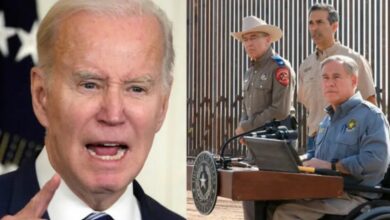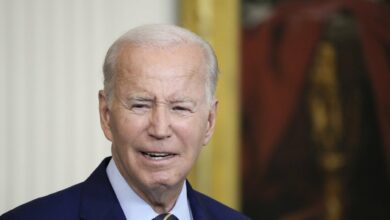Trump restricted legal immigration in his first term. Will it happen again?
Trump’s changes to legal immigration didn't grab many headlines, but they affected people and U.S. businesses, and some warn a second term could have more ripple effects.

Former President Donald Trump’s focus on the border and his ongoing vow to launch the biggest “domestic deportation operation” have dominated the political discourse on immigration this election cycle. But legal immigration is also in play in a potential second Trump term, with the announcement of some drastic cuts to foreign workers.
Trump’s record on immigration, as well as his playbook of proposals called Project 2025 — spearheaded by the conservative Heritage Foundation with input from former Trump administration officials — offer a good idea of what could be in store for noncitizens who have come into the U.S. or are trying to come through legal means.
During his administration, Trump made it harder for foreign-born workers to enter the U.S. on visas or as refugees. Under his watch, visa denials and extensions shot up and refugee admissions were slashed.
Without renewed visas, some U.S. businesses lost employees who had to leave when their work permits expired. Also, far fewer green cards were issued to people not already in the U.S., according to the Cato Institute, a libertarian think tank that advocates for expanding legal immigration.
“What we saw last time, you would see again, but likely on steroids the next time around,” said Stuart Anderson, executive director of the National Foundation for American Policy, a nonpartisan think tank on trade and immigration.
Policy and regulation changes under Trump, combined with the pandemic, led to a reduction in the U.S. foreign workforce, resulting in a significant decrease in the growth of the gross domestic product, economist Madeline Zavodny wrote in a policy brief for the foundation.
Zavodny said that between 2016 and 2022 the GDP growth fell, but, had the foreign-born, working-age population continued to grow, the GDP would have been about $335 billion larger than it was. The foreign worker slowdown began before Covid, but was exacerbated by it, she wrote.
“A slower-growing working-age population means a smaller increase in the number of people to produce goods and services and to generate new ideas that lead to technological progress and long-run growth. A slower-growing or shrinking working-age population also increases the potential for price pressures and shortages,” Zavodny wrote.
Trump’s technical changes to legal immigration were not the sort to grab headlines, but they did affect people who had “followed the rules” to legally work and live in the U.S.
Anderson, who has written about Trump’s effect on legal immigration, wrote in a January column for Forbes that after Trump took office, the denial rate for applications for H1-B visas for initial employment rose to 24% for the 2018 fiscal year and 21% in 2019; meanwhile, denial rates for H1-B visa renewals went up 12% in 2018 and 2019.
Following a lawsuit in 2020, the rates fell to 2% in 2022. But, if elected, the Trump team could implement a rule it left pending in 2020 that would reimplement restrictions, according to Anderson.
Trump also used immigration law to block entry of other visa-holders such as L1 visas for transfers within companies before a court ruled he’d exceeded his authority, Anderson wrote.
Trump has been highly critical of Biden’s humanitarian parole program that has allowed in Venezuelans, Cubans, Nicaraguans, Haitians, as well as Ukrainians and Afghans, and vowed to shut it down.
“If you listen to him, he is very consistent in his focus on immigration. His shorthand on how he would change legal immigration is when he talks about letting in people from nice countries, which is code for white,” said Angela Kelley, a senior adviser at the American Immigration Lawyers Association.
Jaime Florez, spokesperson for the Trump campaign, said “we haven’t heard anything from” Trump or received any formal information about his plans on legal immigration.
“He understands no immigration reform is going to be successful if we don’t have a border that is under control,” Florez said. “He understands that most legal immigrants who arrive legally and are still waiting for USCIS to resolve their immigration status are going to be seriously jeopardized by the open border policy of the Biden administration.”
Some proposals for Trump are spelled out in Project 2025, what its conservative creators are calling a “mandate for leadership” should he be re-elected. Florez said that any suggestions that Trump would implement the proposals are “speculation.”
Project 2025 calls for immediate rule-making affecting temporary work visas and employment authorization along with a slew of other reversals of Biden’s policies, some which undid Trump’s changes.
“Internal efforts to limit employment authorization should be matched by congressional action to narrow statutory eligibility to work in the United States and mitigate unfair employment competition for U.S. citizens,” the document states. “The oft-abused H-1B program should be transformed into an elite program through which employers are vying to bring in only the top foreign workers at the highest wages so as not to depress American opportunities.”
The Trump playbook also calls for suspending updates to an annual list of countries whose citizens can submit H-2A and H-2B temporary worker visas, which would affect agriculture, hospitality, forestry and construction employers that rely on them for workers.
This would hit agriculture the hardest, as it could lose up to 10% of its workforce on some farms, according to the Niskanen Center, a libertarian think tank that scrutinized Project 2025.
“Refusing to update the list would mean that after the expiration of the 2024 list, no countries would be eligible to participate in the program, thus grinding it to a halt,” the center stated.
Project 2025 is calling for turning U.S. Citizenship and Immigration Service personnel into a security agency, thus requiring all workers to be vetted, for steps that would require immigrants to apply more frequently for work permits and an expansion of investigations into the background of potential workers. All would make obtaining benefits more time-consuming and make existing backlogs even longer, the Niskanen Center stated.
That would put many people legally in the country at risk because the conservatives want Trump to force out of the country any person who is rejected for an immigration benefit or status adjudication, which could include renewing Deferred Action for Childhood Arrivals (DACA), a work permit, student visas, awaiting asylum and a host of other permissions, until USCIS catches up on all case backlogs.
Kelley, from the American Immigration Lawyers Association, said the conservatives’ recommendations and Trump’s previous actions on legal immigration are “a roadmap telling us this is the path this candidate would take if elected, and it is a roadmap that would lead us over a cliff.”




